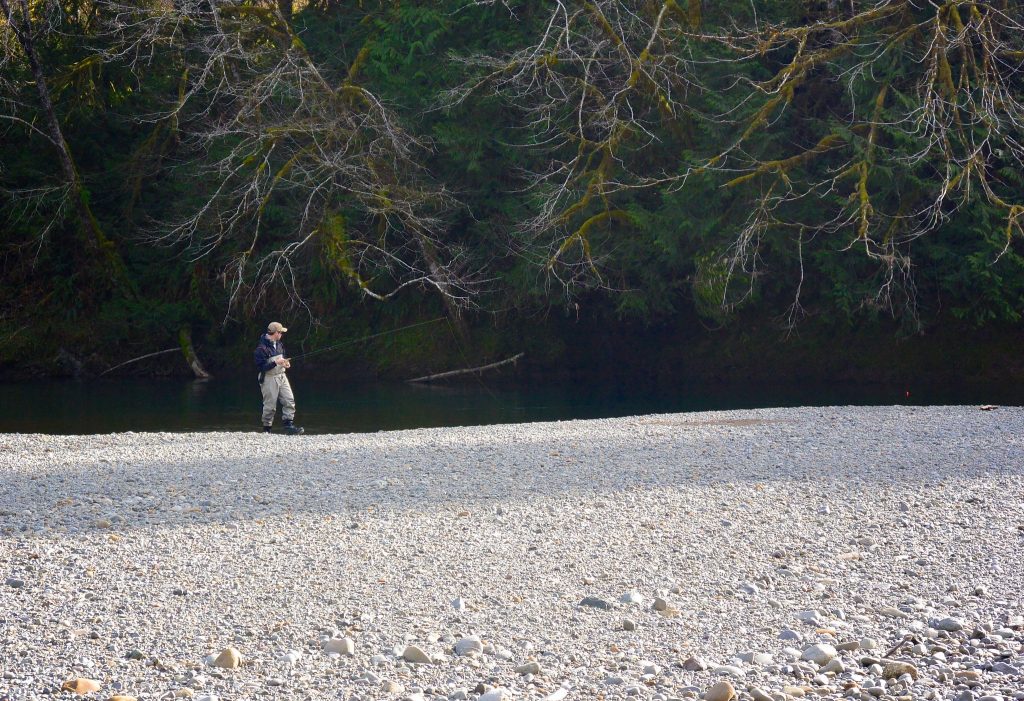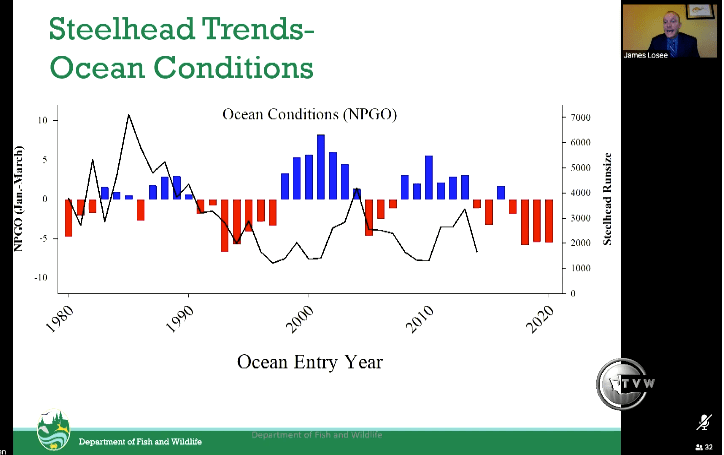
Senators Hear From Guides, WDFW, Others On Coastal Steelhead Restrictions
State lawmakers this afternoon held the first of the week’s two hearings on WDFW’s unprecedented coastal steelhead restrictions this season, listening as guides outlined the economic impacts to their businesses and communities, as well as listed alternative regs they’d like to see on several rivers.

Senators in the Agriculture, Water, Natural Resources & Parks Committee also heard support for the rule changes announced last month as the state agency was commended for helping to likely increase spawner escapement to streams from Forks to Pe Ell to Naselle.

And they heard from WDFW on steps that some tribes are taking toward getting more fish on the gravel as well.
We’ll take these one by one.
The hearing with Sen. Kevin Van De Wege (D-Sequim) and fellow committee members featured testimony from guide Bill Meyer, who said a nonscientific survey of nearly 50 coastal outfitters found they expected to lose $1.425 million in revenues from this season’s restrictions, about $29,000 each, with around $280,000 in deposits having had to be refunded.
“None of us went into the fishing guide business expecting to get rich. Rather, this industry supports working families in rural communities,” Meyer said, and he also pointed to the “significant ripple effects” that will impact hotels, restaurants and local grocery stores as clients stay away.
The most severe of the fishing restrictions is the ban on fishing out of a floating device (which can still be used for transportation), which hits guides particularly hard, but bait was also outlawed and hooks limited to single barbless. WDFW has estimated the overall effect will be to reduce the sport catch by more than 50 percent and help meet spawning goals.
However, guide Ryan Bullock told senators that “the sky is not falling this season” in outlining the Quillayute River system’s overall forecast, which is for 3,371 steelhead above goal to return. Some modeling suggests that given the restrictions, there is room for more flexibility.

Tom Moonan, a local sportfishing coalition president, said WDFW’s blanket regulations seem to show it had “abandoned its traditional river-by-river management practice for a one-size-fits-all approach.”
Cary Hofmann, another guide, proposed opening the Quilly, Sol Duc, Calawah, Dickey and Bogachiel to boat fishing and easing the gear restrictions slightly through the end of April, and doing similar on the Hoh and Wynoochee through April 15.
Van De Wege asked WDFW for a quick-time response to those ideas, and if state managers’ response during today’s hearing is any indication, some may have already been looked at in the 100-plus “novel or hybrids” the agency had evaluated before instituting the restrictions.
Also speaking was Greg Topf of the Wild Steelhead Coalition, who said he was “pleased to see new leadership from WDFW finally acknowledging the dire situation” the fish were in, with an Endangered Species Act listing on some of Washington’s last best runs possible if no action had been taken.
The problem is primarily chronic underescapement on the Chehalis River and Willapa Bay tribs, but North Coast rivers like the Queets and Bogachiel are also struggling. Yesterday, Olympic National Park announced the Queets would close as of February 1, a month to two months earlier than every other major coastal system.
James Losee, WDFW’s coastal manager, showed senators a slide that illustrated how fish returns correspond to ocean conditions, lagging two to three years behind highs and lows in Pacific productivity.
“Steelhead are facing some of the worst ocean conditions documented,” he said, adding that they were expected to continue.

Pete Soverell of The Conservation Angler called the slate of rule changes “a small step in the right direction.”
As for what the tribes are doing alongside WDFW’s measures and whether sport anglers are alone bearing the conservation burden, Fish Program Director Kelly Cunningham spoke to that.
“We’ve seen unprecedented actions taken by the comanagers to reduce their fisheries and not go over allocations,” he told senators.
He said that the Hoh Tribe will fish to their 250-fish allocation during the directed steelhead fishery and will also forego their spring Chinook fishery, which could have produced 10 to 40 more winter-runs as bycatch.
WDFW has produced agreed-to winter-spring fishery management plans for the Hoh and Quileute Tribes, but still out are schedules for tribal fisheries on the Chehalis system.
The impact on disabled anglers’ ability to fish for coastal steelhead was also on Van De Wege’s radar, with Cunningham forced to sound “cold” and “frank” in pointing to ADA facilities on other waters and the “need to be sure less fish … [are] caught by everybody.”
Next up is an 8 a.m. Friday briefing from the agency to the House’s Rural Development, Agriculture & Natural Resources Committee.
